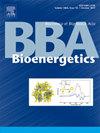生物钟控制着线粒体更新和动态之间的平衡:没有时间标记的生命是什么?
IF 2.7
2区 生物学
Q2 BIOCHEMISTRY & MOLECULAR BIOLOGY
引用次数: 0
摘要
生物时钟驱动的昼夜节律通过预测地球物理的日常变化来调节所有生物的生理过程,从而增强环境适应能力。在体内、离体和同步细胞培养中进行的时间分辨系列多组学分析揭示了转录组、蛋白质组和代谢组的节律性变化,涉及高达50% %的哺乳动物基因组。线粒体氧化代谢是细胞生物能量学的核心,许多编码线粒体蛋白的核基因表现出昼夜节律和超振荡表达。然而,对线粒体DNA (mtDNA)基因表达的研究仍然不完整。利用一种完善的体外同步方案,我们研究了编码呼吸链复合物亚基的mtDNA基因的时间分辨表达,揭示了依赖于主昼夜节律时钟转录因子BMAL1的节律谱。此外,编码关键线粒体生物发生转录因子PGC1a、NRF1和TFAM的基因表达显示出bmal1依赖的昼夜节律振荡。值得注意的是,参与有丝分裂的LC3-II表现出类似的同相昼夜节律表达,从而维持稳定的呼吸链复合物水平。此外,我们发现线粒体的生物发生和降解与细胞器动力学的周期协调发生,导致线粒体裂变和融合的节律变化。这项研究为线粒体转换的生物钟调节提供了新的见解,强调了时间调节在细胞代谢中的重要性。了解这些机制为针对线粒体功能障碍和相关代谢紊乱开辟了潜在的治疗途径。本文章由计算机程序翻译,如有差异,请以英文原文为准。

Circadian clockwork controls the balance between mitochondrial turnover and dynamics: What is life … without time marking?
Circadian rhythms driven by biological clocks regulate physiological processes in all living organisms by anticipating daily geophysical changes, thus enhancing environmental adaptation. Time-resolved serial multi-omic analyses in vivo, ex vivo, and in synchronized cell cultures have revealed rhythmic changes in the transcriptome, proteome, and metabolome, involving up to 50 % of the mammalian genome. Mitochondrial oxidative metabolism is central to cellular bioenergetics, and many nuclear genes encoding mitochondrial proteins exhibit both circadian and ultradian oscillatory expression. However, studies on mitochondrial DNA (mtDNA) gene expression remain incomplete. Using a well-established in vitro synchronization protocol, we investigated the time-resolved expression of mtDNA genes coding for respiratory chain complex subunits, revealing a rhythmic profile dependent on BMAL1, the master circadian clock transcription factor. Additionally, the expression of genes coding for key mitochondrial biogenesis transcription factors, PGC1a, NRF1, and TFAM, showed BMAL1-dependent circadian oscillations. Notably, LC3-II, involved in mitophagy, displayed a similar in-phase circadian expression, thereby maintaining stable respiratory chain complex levels. Moreover, we found that simultaneous mitochondrial biogenesis and degradation occur in a coordinated manner with cycles in organelle dynamics, leading to rhythmic changes in mitochondrial fission and fusion. This study provides new insights into circadian clock regulation of mitochondrial turnover, emphasizing the importance of temporal regulation in cellular metabolism. Understanding these mechanisms opens potential therapeutic avenues for targeting mitochondrial dysfunctions and related metabolic disorders.
求助全文
通过发布文献求助,成功后即可免费获取论文全文。
去求助
来源期刊

Biochimica et Biophysica Acta-Bioenergetics
生物-生化与分子生物学
CiteScore
9.50
自引率
7.00%
发文量
363
审稿时长
92 days
期刊介绍:
BBA Bioenergetics covers the area of biological membranes involved in energy transfer and conversion. In particular, it focuses on the structures obtained by X-ray crystallography and other approaches, and molecular mechanisms of the components of photosynthesis, mitochondrial and bacterial respiration, oxidative phosphorylation, motility and transport. It spans applications of structural biology, molecular modeling, spectroscopy and biophysics in these systems, through bioenergetic aspects of mitochondrial biology including biomedicine aspects of energy metabolism in mitochondrial disorders, neurodegenerative diseases like Parkinson''s and Alzheimer''s, aging, diabetes and even cancer.
 求助内容:
求助内容: 应助结果提醒方式:
应助结果提醒方式:


